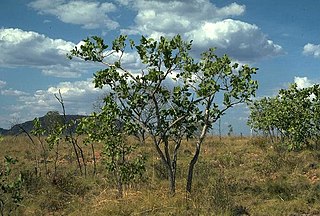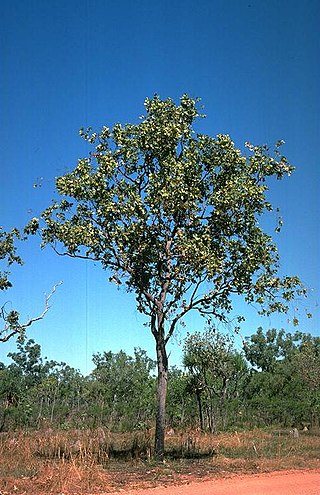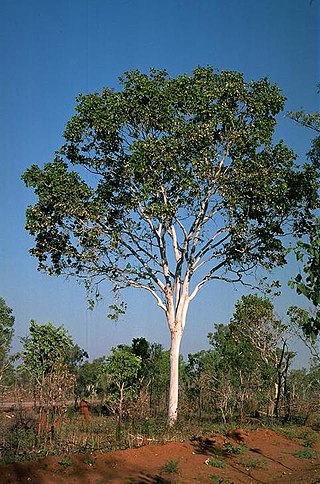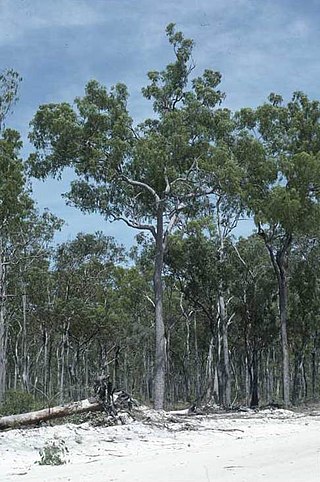
Corymbia ptychocarpa, commonly known as the swamp bloodwood or spring bloodwood, is a species of tree that is endemic to northwestern Australia. It has rough bark on the trunk and branches, broadly lance-shaped adult leaves, flower buds in groups of seven, creamy yellow, pink or red flowers, and barrel-shaped, ribbed fruit.
Corymbia greeniana is a species of tree that is endemic to northern Australia. It has rough bark on some or all of the trunk and larger branches, smooth bark above, broadly lance-shaped to egg-shaped adult leaves, flower buds usually in groups of seven, creamy white flowers and urn-shaped fruit with a distinct neck.

Corymbia flavescens, commonly known as cabbage ghost gum, bastard ghost gum, scraggy cabbage gum, or wrinkle-leaf ghost gum, is a species of tree that is endemic to northern Australia. It has smooth powdery bark, egg-shaped to lance-shaped adult leaves, flower buds in groups of three, white flowers and variably-shaped fruit. The Jaru peoples know it as warlarri.

Eucalyptus effusa, commonly known as rough-barked gimlet, is a species of mallee or small tree that is endemic to Western Australia. It has thin, rough bark on the base of the trunk, smooth bark above, linear to narrow lance-shaped adult leaves, flower buds arranged in groups of seven, white flowers and cup-shaped to conical fruit.

Eucalyptus pruinosa, commonly known as silver box, silver leaf box, apple box or smoke tree, is a species of tree or a mallee that is endemic to northern Australia. The Jaminjung peoples know the tree as yarrirra or jarnbiny, the Jaru as wararn and the Wagiman as wararn. It has rough, fibrous to flaky bark on the trunk and branches, a crown composed of juvenile, glaucous, heart-shaped to broadly elliptical leaves arranged in opposite pairs, flower buds arranged in groups of seven on the ends of branches, creamy white to pale yellow flowers and cylindrical to conical fruit.
Eucalyptus suggrandis is a species of mallee that is endemic to the southwest of Western Australia. It has smooth, shiny bark, linear to elliptical leaves, flower buds in groups of three or seven, creamy white flowers and cup-shaped to conical fruit.

Corymbia abbreviata, also known as the scraggy bloodwood, is a species of straggly tree that is native to Western Australia and the Northern Territory. It has rough bark, a crown of stiff leaves arranged in opposite pairs, flower buds usually in crowded groups on the ends of branchlets and urn-shaped fruit.

Corymbia arenaria, commonly known as bundah bundah or black bloodwood, is a species of tree that is endemic to the northern Kimberley region of Western Australia. It has rough bark on the trunk and branches, lance-shaped to curved adult leaves, flower buds in groups of seven, white flower and spherical urn-shaped fruit.

Corymbia aspera, commonly known as the rough-leaved ghost gum, rough leaf range gum, desert bloodwood, Brittle Range gum in Western Australia, or snappy gum in the Northern Territory is a species of tree that is endemic to northern Australia. It has smooth white bark, sometimes with a short stocking of rough bark near the base, a crown of sessile juvenile, heart-shaped or egg-shaped leaves, flower buds in groups of seven, creamy white flowers and cup-shaped, barrel-shaped or cylindrical fruit.

Corymbia cadophora, commonly known as the twinleaf bloodwood, is a species of small, straggly tree that is endemic to the Kimberley region of Western Australia. It has rough bark on the trunk and branches, a crown of sessile, egg-shaped or lance-shaped leaves joined in opposite pairs, flower buds mostly arranged in groups of seven, creamy white to pink or red flowers and urn-shaped to barrel-shaped fruit.

Corymbia cliftoniana is a species of tree that is endemic to northern Australia. It has thick, rough, tessellated bark on the trunk and branches, narrow lance-shaped adult leaves, flower buds in groups of seven, creamy white flowers and shortened spherical fruit.

Corymbia collina, commonly known as the silver-leaved bloodwood, is a species of tree that is endemic to Western Australia. It has thin patchy rough bark on some or all of the trunk, smooth white to pale grey bark above, lance-shaped to curved adult leaves, flower buds in groups of seven, creamy white flowers and barrel-shaped fruit.
Corymbia deserticola is a species of straggly tree, a mallee or a shrub that is native to Western Australia and the Northern Territory. It has rough, tessellated bark on the trunk and branches, mostly sessile, heart-shaped leaves arranged in opposite pairs, flower buds in groups of seven on each branch of a peduncle, creamy yellow flowers and urn-shaped to shortened spherical fruit.
Corymbia disjuncta is a species of tree that is endemic in northern Australia. It has rough bark on some or all of the trunk, then a clear separation to smooth bark, a crown of intermediate and adult, heart-shaped to egg-shaped leaves, flower buds mostly in groups of seven, creamy white flowers and cylindrical to barrel-shaped or urn-shaped fruit.

Corymbia eremaea, commonly known as mallee bloodwood, hill bloodwood and centre range bloodwood, is a small, mallee-like tree that is endemic to central Australia. Indigenous Australians know the plant as muur-muurpa. It has rough, evenly tessellated bark, lance-shaped leaves, oval to pear-shaped flower buds arranged on a branching peduncle and urn-shaped fruit.

Corymbia ferruginea, commonly known as the rusty bloodwood, is a species of tree that is endemic to northern Australia. It has rough, tessellated bark on the trunk and branches, a crown of sessile juvenile leaves, flower buds in groups of three or seven, pale creamy yellow flowers and urn-shaped fruit.

Corymbia grandifolia, commonly known as the cabbage gum, large-leaved cabbage gum and the paper-fruited bloodwood, is a species of tree that is endemic to northern Australia. It has smooth bark, egg-shaped to broadly elliptic to lance-shaped adult leaves, flowers buds in groups of three or seven, creamy white flowers and cup-shaped to cylindrical fruit.

Corymbia nesophila, commonly known as the Melville Island bloodwood, is a species of tree that is endemic to northern Australia. It has rough, tessellated bark on the trunk and branches, lance-shaped or curved adult leaves, flower buds in groups of seven, creamy white flowers and urn-shaped fruit.
Corymbia pachycarpa, commonly known as the urn-fruited bloodwood, mawurru, yilanggi or warlamarn, is a species of stunted tree or mallee that is endemic to northern Australia. It has thick, tessellated bark on the trunk and branches, a crown of heart-shaped, egg-shaped or lance-shaped leaves, flower buds in groups of three or seven, white flowers and urn-shaped to barrel-shaped fruit.
Corymbia paractia, commonly known as the Cable Beach ghost gum, is a species of low-growing tree that is endemic to the Kimberley region of Western Australia. It has smooth white to pale grey bark, sometimes with rough bark near the base of the trunk, lance-shaped adult leaves, flower buds in groups of three or seven, creamy white flowers and cup-shaped, barrel-shaped or cylindrical fruit.













